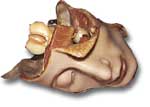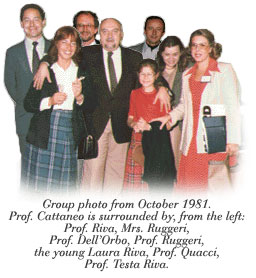|
|
 |
 |
 |
 The
magnificent wax anatomical models on view at the University Citadel of Cagliari Museum have an intriguing
tale to tell (partly medical and partly not). Their story
delves into the past of Sardinia and the history of the Italian
States while also telling us something about Europe itself
at the end of the Eighteenth century and during the first
decade of the Nineteenth century: a period characterized by
a series of events crucial to Sardinian society. Cagliari's
anatomical wax model collection, considered one of the finest
in the world, provides us not only with a perfect description
of the human body, but also tells us a lot about medical and
surgical knowledge at the time the models were produced. Our
first task is to examine how and why these wax models ended
up in Cagliari and also to find out where they came from. The
magnificent wax anatomical models on view at the University Citadel of Cagliari Museum have an intriguing
tale to tell (partly medical and partly not). Their story
delves into the past of Sardinia and the history of the Italian
States while also telling us something about Europe itself
at the end of the Eighteenth century and during the first
decade of the Nineteenth century: a period characterized by
a series of events crucial to Sardinian society. Cagliari's
anatomical wax model collection, considered one of the finest
in the world, provides us not only with a perfect description
of the human body, but also tells us a lot about medical and
surgical knowledge at the time the models were produced. Our
first task is to examine how and why these wax models ended
up in Cagliari and also to find out where they came from.
Our story begins in the University of Cagliari and more precisely in the Medicine
and Surgery Faculty School of Anatomy in 1801. During that
year, thirty-four year old Professor Francesco Antonio Boi, lecturer in Human Anatomy, had no students enrolled on his course
and asked the Sardinian Viceroy Charles Felix of Savoy for permission to visit the Italian
mainland (at that time divided into separate states) in order
to learn more about his profession. Once permission was granted,
Professor Boi set sail from Cagliari to the hallowed halls
of Pavia University, where the great Professor Antonio Scarpa taught anatomy. After a short spell in
Pavia, Boi went to Pisa and then on to Florence.
Florence university still did not have its own faculty of
medicine at the beginning of the Nineteenth century. Young
Florentines who wished to study Medicine or Surgery (the two
degrees were separate at the time and not combined to form
one university course until 1857) were usually forced to attend
university in Pisa or Siena. Upon arrival in Florence, Francesco
Boi began to attend the Anatomical Surgery (as Anatomy Departments
were called at the time) of a hospital headed by Paolo Mascagni, one of the most eminent anatomists of
his day. In 1877, Professor Meloni Satta, a doctor and Boi's
first biographer, wrote that the Cagliari wax anatomical models
were extremely faithful reproductions of dissections carried
out on cadavers by Professor Boi at the School of Anatomy
in Florence. Clemente Susini modelled them for him personally from
1803 to 1805 in the famous wax modelling laboratory of the
Museum of Antiquities and Natural History in Florence (also
known as the Museo della Specola or Observatory Museum), which
was directed by Abbot Felice Fontana at the time The Viceroy Charles Felix
wanted to buy them for his Museum of Antiquities and Natural History, then housed
in the Viceroy's Palace in Cagliari. And so the wax anatomical
models finally ended up in Cagliari in 1805. When in 1858
the Museum was transferred to the University building, the
wax models were installed in a separate Anatomical Laboratory
and placed under the charge of the Professor of Anatomy.
In 1923, they were transferred to their new home in the Institute
of Anatomy, where they remained till 1991 when the present
museum was built. Prof. Luigi Castaldi (1890-1945), lecturer
in Normal Human Anatomy at Cagliari from 1926 to 1943, wrote
a monograph about Boi and the wax models, which was published
posthumously in 1947. During the years of World War II, the
wax models were concealed by Prof. Carlo Maxia, who succeeded
Castaldi as Institute Director, to prevent them from being
stolen or destroyed. When Prof. Luigi Cattaneo (1925-1992) became director of the Anatomical
Institute in 1963, he was personally responsible for cleaning
the models and restoring their original display cases. He
also obtained permission from the current Rector Giuseppe
Peretti for a special room to be prepared to house the wax
models. In 1970, Prof. Cattaneo described and catalogued the
wax models individually in a book he produced for the university.
They were then studied in successive stages by Prof. Bruno
Zanobio, a medical historian, who spoke about them at several
national and international congresses.
In 1978, the wax models formed the subject of his opening
paper to the 35th National Congress of the Italian Society
of Anatomy, held in Cagliari and chaired by Prof. Alessandro Riva. In June 1991, Prof. Alessandro Riva, who had in the
meantime been appointed curator of the collection, obtained
permission from the current rector Prof. Duilio Casula to
house the wax models, now complete with explanatory labels,
in the Pentagonal Room of the Piazza Arsenale Museum University
Citadel, where they are still on permanent display. In 1993
a new bilingual (Italian-English) edition of the catalogue
with novel Illustrations of all the waxes was published (Cattaneo
e Riva, 1993)
The following year the Collection has been associated to the
CIMAS (Centre for the Museums and the University Archives)
and, meanwhile, Alessandro Riva has been retained as manager
of the Museum by the current Rector Pasquale Mistretta. In
1998, through the good offices of the Rector and thanks to
the cooperation of Professor Giancarlo Deplano, each showcase
has been endowed with optical fiber illumination, and the
exhibition room restored. The latter has been also adorned
by two portraits, of King Carlo Felice and of Clemente Susini
respectively, painted by Gigi Camedda, an artist from Cagliari.
The two portraits were hung beside that, dated back to XIX
century, of F.A. Boi. In 2000 it has been installed a ticket
office whose personnel has also the task of distributing illustrative
material to visitors. Finally, it must be recalled that the
museum is the site of a publishing
activity, both on papery and electronic media, and that,
in the last decade, by request, some of the waxes from Cagliari
have been exhibited in prestigious museums of large metropolis
such as the Villette of Paris, the Hayward Gallery of London,
the Tokyo National Science and La Triennale of Milan.
 |
 |

|